In the next hundred years strange craft will
zoom across our skies. They won‚€™t be alien craft from unknown planets.
They will have been built here on Earth and will be capable of speeds
we can only begin to dream of. In Spring 2000 flight tests on Hyper-X
may prove that today‚€™s science fiction will become tomorrow‚€™s reality.
by Stuart Carter
Winged aircraft as we know them will
be a thing of the past. Aviation technology is undergoing some of
the most impressive and revolutionary changes that we‚€™ve seen since
the Wright Brother's first flight in 1903. Across the world designers
are racing to create fantastic new aircraft that can fly humans
higher, faster and further than ever before. Airliners will take
us to the edge of space and around the planet in minutes, utilising
new propulsion systems that will make the jet engine obsolete.
The quest for new designs is relentless.
In the 1960s NASA investigated the idea of flying an aeroplane without
wings. Their ‚€˜lifting bodies‚€™ were a series of experimental wingless
gliders built during the development of the Space Shuttle. The cross
section of the aircraft body is similar to a wing, producing all
the lift it needs to fly. Aircraft designers were determined to
do away with conventional wings. At a once secret airbase outside
Moscow, ingenious Russian engineers created what looked more like
a ‚€˜flying saucer‚€™ than a plane. Called ‚€˜Tarielka‚€™, it was conceived
during the height of the Cold War under the old Soviet Union.
The Russian methods were low-tech,
but the results were remarkable. It looked impossible, but the Tarielka
flew. Initial tests on scale models were so successful that construction
quickly began on a full sized Tarielka. Looking like a spaceship
from a Science Fiction movie the Tarielka was designed to carry
up to a dozen passengers and was poised to become the new executive
jet of the future. Its engines are housed inside the main body.
The small wings, which provide no lift at all, help to stabilise
and steer the machine. The aerodynamic lift comes from the wing-like
cross sectional shape of aircraft itself. However, the investment
required to transform the Tarielka from a promising prototype into
a truly reliable and airworthy aircraft was immense. The cash poor
Russian government was forced to withdraw it's funding. Developing
radical new technologies is never cheap.
 |
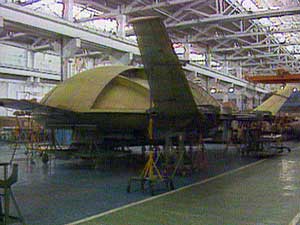
UFO? This Russian wingless craft
really does fly!
|
The most tried and tested way to carry
hundreds of passengers around the world is the 747. It has carried
1.6 billion people 20 billion miles, the equivalent of flying the
entire population of Los Angeles and New York City to the Moon and
back! With passenger numbers expected to double by the year 2010,
new airliners twice the size of the 747 are desperately needed to
meet the demand.
Superliners
An aerodynamics team from NASA, Boeing and Stanford
University is developing a new super-airliner, able to hold 1,000
passengers, more than double the capacity of today‚€™s jumbo jets.
To create the extra room and lift needed for the passengers and
their luggage this design has abandoned the traditional shape of
fuselage and wings. It has fused the body and the wing together
into a design called the BWB the Blended Wing Body. Even successful
new designs of airliners will have to use existing terminal facilities.
It would cost too much and take too long to redesign the world‚€™s
major airports. To ensure the BWB is economically viable its overall
wingspan must be no greater than the 747.
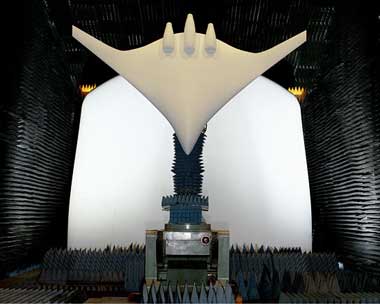
NASA
The shape of the future: BWB
model undergoing final research tests at NASA Langley Research
Centre
|
The BWB is a concept that‚€™s been around
for over 70 years. This type of design used to be called ‚€˜the flying
wing‚€™. Even 50 years ago engineers and designers knew that it could
potentially carry huge numbers of passengers.or bombs. However,
flying wings have no tail plane and early versions were highly unstable
and almost impossible to control. They are constantly on the verge
of stalling. Too unstable to be flown directly by hand, even the
best pilots would struggle to keep them in the air. With 15 flaps
and ailerons the BWB needs more than double the number of control
surfaces of a normal aeroplane. Onboard computers are now able to
interpret the pilot‚€™s demands and translate them into safe and stable
movements.
With its 17ft wingspan the Boeing/Stanford
BWB model might look like the ultimate toy aircraft but this design
could be the shape of the airliner of the future. So far this research
programme has cost $4 million. On its maiden flight it was so successful
that it demonstrated that this radical shape could outperform conventional
designs by a huge margin.
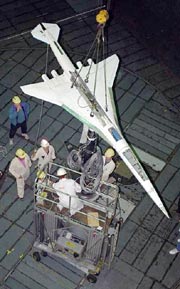
NASA
Concorde's successor: Engineers
prepare a model HSCT for aerodynamic tests.
|
Super Speed
The greatest challenge of all is speed.
Even the next generation of superliners such as the BWB will remain
subsonic. If we really want to shrink the world we will have to
travel at many times the speed of sound.
Concorde is the only existing supersonic
passenger plane. It cruises at twice the speed of sound, around
1,400 mph. There are just 14 of them. Operated by Air France and
British Airways they can cross the Atlantic in 3 hours 20 minutes.
They carry only 100 passengers and they are very expensive to fuel
and service. Designing a supersonic aircraft that will be significantly
larger and faster than Concorde will not be easy. Concorde is over
20 years old. In that time, no one else has taken on the phenomenal
task of designing a replacement. That is until now. NASA has recently
started work on a new supersonic airliner. Known as the HSCT, short
for High Speed Civilian Transport, it is twice as large as Concorde
and will carry three times the number of passengers.
One of the difficulties with supersonic
craft like Concorde is that the long pointed aerodynamic nose severely
limits the pilot‚€™s visibility during take off and landing. To overcome
this Concorde was fitted with a pivoted nose that hinges down at
subsonic speeds for both take off and landing. Designers have decided
that this option is too heavy and bulky for the HSCT so their pilots
will have to land and take off without ever seeing the runway. They
will have to rely on a system of radar, video and infrared cameras.
I wonder who will want to be onboard the maiden flight!
The HSCT has to be funded by a government
agency because it requires so much basic research. To progress past
this initial stage of development the HSCT will require significant
private investment. Some industry analysts estimate that it will
take at least 200 of these super-fast airliners to satisfy the world‚€™s
airlines, perhaps many more. The HSCT will be able to fly non-stop
over the Pacific from Los Angeles to Melbourne, presently the world‚€™s
longest flight, in under 5 hours, slashing almost 10 hours of the
present travelling time. In the not too distant future the HSCT
may be a common sight in our skies but even this plane will have
its limitations.
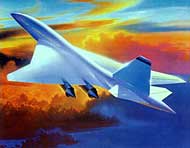
NASA
Non-stop luxury: HSCT will
be capable of flying over 200 passengers at supersonic speeds
across the Pacific.
|
New propulsion for a new Millennium
Finding a new system of propulsion is essential
if we want to travel really fast. Every jet engine flying today
uses the same principles as the first engines developed by British
engineer Sir Frank Whittle in the 1940s. Even rocket power has it
drawbacks. The fastest aircraft ever to fly was the rocket powered
X15 in 1967. It flew at Mach 6.7, an incredible 4,690mph, and reached
an altitude of over 60 miles - the very edge of space. It was so
fuel inefficient that its liquid fuel only lasted for a few minutes.
And the Space Shuttle needs to carry more than it own bodyweight
in fuel. The Orbiter weighs a mere 77 tons but must carry 1,785
tons of fuel to lift off.
If we want to build airliners that can travel much
faster than HSCT, perhaps as fast as the X15 or the Shuttle, we
will have to develop a completely new type of aircraft. It must
be one that uses far less fuel but is still capable of flying in
and out of space. Right now a NASA-Boeing team are developing a
unique 'air breathing' rocket engine prototype called Hyper-X. It
will be so powerful that it will shatter all previous speed and
altitude limits. This new design the Hyper-X will take off like
a plane but fly like a spaceship.
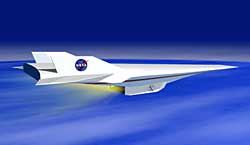
NASA
Artist's impression of the Hyper-X
research vehicle on its short test flight in Spring 2000 after
release from it's booster rocket.
|
At just 12 feet long, the un-piloted prototype will
be carried to 100,000ft by plane and by a Pegasus booster rocket
normally used for launching satellites. It will then be released
and its experimental engines ignited. Shaped like a lifting body,
Hyper-X will use its unusual curved shape to scoop oxygen from the
thin air and ram it at high pressure into its combustion chamber.
Mixed with explosive hydrogen it will propel the craft forward at
an unbelievable 2 miles per second. Code named X43 by NASA, Hyper-X
will make its 700 nautical mile maiden flight at Mach 7 in the Spring
of 2000. This 12 minute flight will be a one-off: the prototype
is doomed to plunge into the Pacific at 300 miles an hour.
If all goes according to plan the final version
of the Hyper-X will be even more impressive. It will be capable
of speeds of Mach 20 to 25, fast enough to leave the Earth's atmosphere.
A sub-orbital hop from New York to Tokyo will take less than an
hour; London to Sydney will only be minutes more. One disadvantage
of this kind of hyper speed travel will be a very loud sonic boom.
The aviation authorities will have to maintain a tight environmental
control.
In the future, the only limit will be the designer‚€™s
imagination. The technologies that will make these amazing vehicles
possible are already available. In the early years of the new Millennium
we will see developments in propulsion and avionics that will take
us far beyond the limits of conventional aircraft - developments
that will make the simple winged aircraft a thing of the past and
change the way we fly forever.
Copyright © FirstScience.com
|
